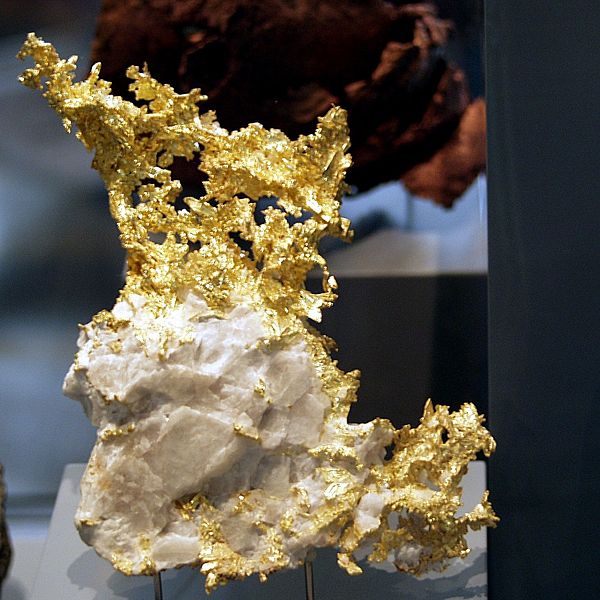 |
| A typical specimen of orogenic gold from California Photo by Raimond Spekking |
Over the last century this class of gold deposit has been known by many different names like mesothermal gold deposits, metamorphic gold, gold-only, lode gold, shear-zone hosted, structurally controlled and a host of other names including greenstone-hosted and turbidite hosted deposits. To cover this mélange of varying names the term “Orogenic Gold” has been proposed by (Grove et al) in 1998 to cover all these varying terms. The reason for the change is to lower the confusion in terms since over the years they have changed causing a great deal of confusion in the scientific community, The reason for this confusion is because of the nature of these gold deposits. Many of these deposits are hosted in rocks that are intensely deformed and have been intruded from the effects of regional metamorphism or intrusion by magma.
One of the important features of describing these gold deposits as orogenic gold deposits is because they can be found in any type of rock. Deposits of this nature can be found in metamorphic terranes of various ages that display variable degrees of deformation. The rocks that host gold deposits range from volcano-plutonic or clastic-greenschist facies commonly found in amphibolite or granulite. Deposits of this nature can be found in areas that have undergone regional metamorphism or where the immediate area has undergone local contact metamorphism from the intrusion of hot magma. Some of these deposits can be found in areas that at present represent areas of ancient major tectonic boundaries. An example of this is found in the north-east part of North America in the fault contact between continental rocks and deep sea rocks that is represented by a fault system undergoing several name changes, but locally is called “Cameron’s Line.” Most of these features are either compressional or transpressional tectonic settings.
You can find orogenic gold deposits in metamorphic terranes that display various degrees of deformation and various ages. The rock hosts are various environments that include volcano-plutonic and sedimentary-clastic terranes. The host rocks have usually been metamorphosed to greenschist facies. In some places locally the metamorphism can be amphibolite or granulite. Typically the gold deposits of this environment occur in regional crust scale environments. They usually display a brittle to ductile style of deformation. In many cases they are likely the present day expression of major ancient tectonic boundaries. The gold deposits can be found in any host rock.
These is a wide diversity of environments displayed that have strong structural controls in the gold deposits. Orebodies are found in all sizes and all scales. The morphology of these deposits is very variable including such diverse types as (1) brittle faults to ductile shear zones, (2) extensional fractures, stockworks and breccias and (3) fold hinges. Many of these Orebodies are composed of highly altered host rocks that have disseminated mineralization of fissure filled deposits. Many of these deposits can display a large vertical size exceeding 1 km in extent or more.


I find this post amazing. This is very educational and informative to people who love the subject. Although I don't have knowledge about mining, my father used to be a miner when he was younger. I have been to a mine too because my eldest brother worked as a miner until late 80s. Thanks.
ReplyDeleteThanks for using my photo. Just for the records to achieve the license rules:
ReplyDeletePhotographer: Raimond Spekking
License: cc-by-sa-3.0 http://creativecommons.org/licenses/by-sa/3.0/
Source: https://commons.wikimedia.org/wiki/File:Naturkundemuseum_Berlin_-_Gediegen_Gold_in_Quarz,_Eagles_Nest_Mine,_Placer_County,_Kalifornien,_USA.jpg
Was ist passiert, ich habe die Regeln?
DeleteSilverGoldBull is a very reputable silver and gold dealer. They will provide you with bargain, up-to-minute prices and they will make sure that your bullion arrives to your door discreetly and fully insured.
ReplyDelete